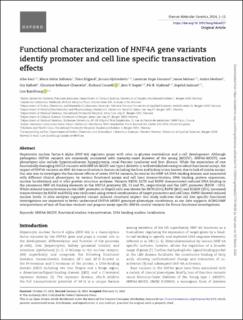| dc.description.abstract | Hepatocyte nuclear factor-4 alpha (HNF-4A) regulates genes with roles in glucose metabolism and β-cell development. Although pathogenic HNF4A variants are commonly associated with maturity-onset diabetes of the young (MODY1; HNF4A-MODY), rare phenotypes also include hyperinsulinemic hypoglycemia, renal Fanconi syndrome and liver disease. While the association of rare functionally damaging HNF1A variants with HNF1A-MODY and type 2 diabetes is well established owing to robust functional assays, the impact of HNF4A variants on HNF-4A transactivation in tissues including the liver and kidney is less known, due to lack of similar assays. Our aim was to investigate the functional effects of seven HNF4A variants, located in the HNF-4A DNA binding domain and associated with different clinical phenotypes, by various functional assays and cell lines (transactivation, DNA binding, protein expression, nuclear localization) and in silico protein structure analyses. Variants R85W, S87N and R89W demonstrated reduced DNA binding to the consensus HNF-4A binding elements in the HNF1A promoter (35, 13 and 9%, respectively) and the G6PC promoter (R85W ~10%). While reduced transactivation on the G6PC promoter in HepG2 cells was shown for S87N (33%), R89W (65%) and R136W (35%), increased transactivation by R85W and R85Q was confirmed using several combinations of target promoters and cell lines. R89W showed reduced nuclear levels. In silico analyses supported variant induced structural impact. Our study indicates that cell line specific functional investigations are important to better understand HNF4A-MODY genotype–phenotype correlations, as our data supports ACMG/AMP interpretations of loss-of-function variants and propose assay-specific HNF4A control variants for future functional investigations. | en_US |

